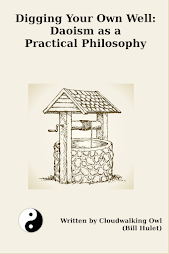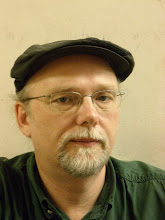&&&&&&&&&
I forget the title and haven't been able to find the book, but years ago I read, in translation, a Buddhist sutra that listed all the different ways in which one can meditate in order to gain enlightenment. The list was enormous. Most people I meet don't understand this, and think that the only way to meditate is through some sort of formal sitting practice. Probably this is simply because formal sitting is the most practical way of engaging most people who express an interest in the subject. I also suspect that formal group sitting is the best way of coordinating a large group of nuns or monks in a monastic setting. Eventually, as a transmission declines and ossifies, people forget about the broader range of options and what started out as specialization becomes exclusivity.
Someone like myself, who has only for brief periods of time (and only marginally then) been a member of a community, has the luxury of experimentation and the stern discipline of having to be my own taskmaster. This means that I have spent a lot of time exploring other options beside formal sitting.
&&&&&&&&&
To cite a specific example, one of the practices my first meditation teacher taught me was to spend time thinking about my perception and re-ordering it according to specific principles. One example is to walk around and try to be aware of all the parallel lines that exist in the world around us. Certainly in the human-build world they are everywhere. In nature, not so much. Another practice I sometimes do is to look at water flowing over stones and try to be aware of all the complex wave patterns that manifest themselves as the water interacts with stones. Another thing I used to do was sit in a forest and without moving my head move "my hearing attention" around me like a search light. It is possible to do, but it requires a special type of sensitivity and concentration.
What I was doing wasn't echo location, like this young man is doing. But I suspect that if many people put enough effort into it, they would be able to manifest something like the same ability.
&&&&&&&&&&
 |
| The Neijing Tu (but not mine) |
(Interestingly enough, when I went into Google Images to find a copy, I noticed that most of the versions do not have this different between the two eyes.)
This was especially of interest to me for two reasons.
First of all, there is a very strong tradition in Western popular culture that there is such a thing as an "evil eye". I don't really take the popular understanding very seriously, but I have met the odd person who for some reason has scared the absolute bejesus out of me because of something in the way their eyes look.
Much more importantly, I was fascinated by scientific research that has been done using people who have had their brains surgically separated as a way of treating a very horrible form of epilepsy. In effect, it creates symptoms that look like there are two different people living in the same body.
What this suggested to me was that if I very carefully analyzed my experience of seeing, I might be able to find something like a subtle dominance of one eye over another. If so, then it might be of value to teach myself to control which eye is dominant at any given moment. This is based on the idea that different sides of the brain are linked to different eyes, and that each side of the brain has subtle differences from the other. In the YouTube video, this is expressed by one side being able to verbalize what the eye associated with it is seeing, whereas the other eye can only express itself through drawing pictures. It is true that people who have not had their brains separated still have linkages between the two sides, but it struck me that there still might be subtle issues that come from which particular eye is dominant.
As a result of this thinking, I put a fair amount of time into trying ascertain which eye was dominant and then tried to train myself to be able to pick and choose which one I wanted to dominate at any given moment.
&&&&&&&&&&&&&
I came across another idea in a book I read titled The Art of Memory by Francis Yates. This fascinating little book describes an ancient discipline for greatly expanding the human memory that has existed from ancient Greek times, through the Middle Ages and into the Renaissance. As I remember, it involves association techniques that allow one to "encode" one idea into another that is more vivid. For example, if you wanted to remember the telephone number 822-1024 (this was the phone number of my first taijiquan teacher), you could say to yourself "Eight bullets and ten cases of beer". This is because one of the standard bullet sizes is 22 calibre and beer comes in cases of 24. The point is that the images have to ones that will come readily to the person who is trying to remember.
In the case of much more involved memory projects, Yates said that ancients would spend time in a space, like a temple, so they could totally memorize each part of it. And when they had to memorize something like a speech, they would visualize themselves walking through the building where different elements of the speech would be identified through articles "left" in it with their mind's eye. So if someone wanted to first talk about the sea, they might visualize an oar on the front steps, then if they wanted to move on to agriculture, they would create a mental picture of a sheaf of grain in the doorway. If the military was the next stage, then they'd show a spear leaning against the first statue past the entrance.
I don't know if my interest in the art of memory was caused by Yates' book, but I found it fascinating. One thing I do remember is that when at university I never took notes during a lecture. I would try to come prepared, sit on the front row, and give the professor my absolute, undivided attention. My experience was that I missed so much of what she had to say by trying to write stuff down that I retained far less than if I simply listened to what she had to say.
&&&&&&&&&&&&&
Another thing I worked on for a while involved teaching myself to be able to have lucid dreams. These are dreams where one is consciously aware that one is dreaming and is able to exert influence over the content of your dream. You do this by planting an image in your mind before you drift off to sleep and concentrate on gaining self-awareness when it presents itself in the dream. In my case---taking a cue from Carlos Castenada---I told myself that I would become aware when I saw my hands in my dream. The first time I did this I became aware in a dream where I was driving in a convertible car down a city street. At that point I told myself "I'm in a dream. I can do anything. I want this car to fly." I pulled back on the steering wheel like in an airplane and took off into the sky.
What this experience taught me that it is possible to even practice internal alchemy while you are sleeping. And I did go through a brief phase where I was practicing taijiquan while sleeping. (I even got correction from the head instructor from my Temple!)
&&&&&&&&
 |
| Wayne Gretzky: Neidan Master? |
 |
| "Buzz Beurling", Neidan Master? |
@@@@@@@@@
Of course, this discussion is ultimately based on the idea of "kung fu", or, the application of hard work over a long period of time to develop an exceptional degree of ability. I am suggesting that "neidan" or "internal alchemy" is a type of kung fu. I am not suggesting that learning how to play hockey or shoot are forms of "neidan", but they are types of kung fu. Neidan is kung fu aimed towards a specific end. What that end can and should be, will be the subject of a future post.







No comments:
Post a Comment